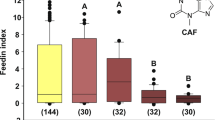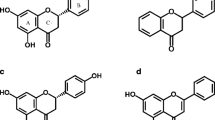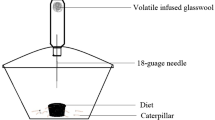Abstract
The common brushtail possum (Trichosurus vulpecula) is a generalist herbivore whose diet includes Eucalyptus leaves that are well defended by plant secondary metabolites (PSM) such as the terpene 1,8-cineole (cineole). We accustomed possums to a terpene-free diet, then challenged them with the addition of 2% cineole to the diet. Initially, there was a 50% reduction in total overnight food consumption associated with a marked decrease in the mass of the major feeding bout. After nine nights, however, cineole tolerance had developed as total food consumption had returned to the control amount. Compared to the control diet, the cineole diet was eaten in a larger number of smaller bouts, which were also eaten at a slower rate. The experiment was repeated with animals that had been accustomed to day-time feeding to take blood samples during feeding sessions. Feeding variables and blood concentration data for cineole were compared on the first and seventh day of the cineole diet. Although the total food consumed increased 2.5-fold after 7 days of the cineole diet, there was no increase in average blood cineole concentration, measured as the area under the concentration–time curve. This indicates that induction of liver enzymes resulted in greater pre-systemic metabolism of cineole and reduced bioavailability. The maximum tolerated blood concentration of cineole also increased, suggesting some adaptation of the central nervous system to the cineole aversive effects. This appears to be the first report in a vertebrate herbivore that consumption of a dietary PSM leads to metabolism induction and that this contributes to development of tolerance to the PSM. Overall, herbivores adapt to newly encountered dietary PSMs by immediate changes in feeding behavior followed by development of increased metabolism of PSM and probably diminished cellular responsiveness to effects.


Similar content being viewed by others
References
Boyle, R. R., and McLean, S. 2004. Constraint of feeding by chronic ingestion of 1,8-cineole in the brushtail possum (Trichosurus vulpecula). J. Chem. Ecol. 30:757–775.
Boyle, R. R., McLean, S., Brandon, S., Pass, G. J., and Davies, N. W. 2002. Application of solid-phase microextraction to the quantitative analysis of 1,8-cineole in blood and expired air in a Eucalyptus herbivore, the brushtail possum (Trichosurus vulpecula). J. Chromatogr. B. 780:397–406.
Boyle, R. R., McLean, S., Brandon, S., and Wiggins, N. 2005. Rapid absorption of dietary 1,8-cineole results in critical blood concentration of cineole and immediate cessation of eating in the common brushtail possum (Trichosurus vulpecula). J. Chem. Ecol. 31:2775–2790.
Bryant, J. P., Provenza, F. D., Pastor, J., Reichardt, P. B., Clausen, T. P., and Dutoit, J. T. 1991. Interactions between woody-plants and browsing mammals mediated by secondary metabolites. Annu. Rev. Ecol. Syst. 22:431–446.
Dearing, M. D., Foley, W. J., and McLean, S. 2005. The influence of plant secondary metabolites on the nutritional ecology of herbivorous terrestrial vertebrates. Annu. Rev. Ecol. Evol. Syst. 36:169–189.
Dziba, L. E., Hall, J. O., and Provenza, F. D. 2006. Feeding behavior of lambs in relation to kinetics of 1,8-cineole dosed intravenously or into the rumen. J. Chem. Ecol. 32:2391–408.
Foley, W. J., Iason, G. R., and McArthur, C. 1999. Role of plant secondary metabolites in the nutritional ecology of mammalian herbivores: How far have we come in 25 years? pp. 130–209, in H.-J. G Jung and G. C. Fahey (eds.). San Antonio, Texas, USA. American Society of Animal Science, Savoy, Illinois.
Fraenkel, G. S. 1959. Raison d’etre of secondary plant substances. Science 129:1466–1470.
Gonzalez, F. J., and Kimura, S. 2003. Study of P450 function using gene knockout and transgenic mice. Arch. Biochem. Biophys. 409:153–158.
Gonzalez, F. J., and Nebert, D. W. 1990. Evolution of the P450 gene superfamily: animal-plant ‘warfare’, molecular drive and human genetic differences in drug oxidation. Trends Genet. 6:182–186.
Harris, R. Z., Jang, G. R., and Tsunoda, S. 2003. Dietary effects on drug metabolism and transport. Clin. Pharmacokinet. 42:1071–1088.
Hollenberg, P. F. 2002. Characteristics and common properties of inhibitors, inducers, and activators of CYP enzymes. Drug Metab. Rev. 34:17–35.
Iason, G. 2005. The role of plant secondary metabolites in mammalian herbivory: ecological perspectives. Proc. Nutr. Soc. 64:123–131.
Iason, G. R., and Villalba, J. J. 2006. Behavioral strategies of mammal herbivores against plant secondary metabolites: The avoidance-tolerance continuum. J. Chem. Ecol. 32:1115–1132.
Ioannides, C. 2002. Topics in xenobiochemistry - pharmacokinetic interactions between herbal remedies and medicinal drugs. Xenobiotica 32:451–478.
Lawler, I. R., Foley, W. J., Pass, G. J., and Eschler, B. M. 1998. Administration of a 5HT(3) receptor antagonist increases the intake of diets containing Eucalyptus secondary metabolites by marsupials. J. Comp. Physiol. B 168:611–618.
Lawler, I. R., Stapley, J., Foley, W. J., and Eschler, B. M. 1999. Ecological example of conditioned flavor aversion in plant-herbivore interactions: Effect of terpenes of Eucalyptus leaves on feeding by common ringtail and brushtail possums. J. Chem. Ecol. 25:401–415.
McLean, S., Boyle, R. R., Brandon, S., Davies, N. W., and Sorensen, J. S. 2007. Pharmacokinetics of 1,8-cineole, a dietary toxin, in the brushtail possum (Trichosurus vulpecula): Significance for feeding. Xenobiotica 37:903–922.
O’Brien, C. P. 2006. Drug addiction and drug abuse, pp. 607–627, in L. L., Brunton, J. S., Lazo, K. L., and Parker (eds.). Goodman and Gilman’s The Pharmacological Basis of Therapeutics11th edn.McGraw Hill, New York.
Pascussi, J. M., Gerbal-Chaloin, S., Drocourt, L., Assenat, E., Larrey, D., Pichard-Garcia, L., Vilarem, M. J., and Maurel, P. 2004. Cross-talk between xenobiotic detoxication and other signalling pathways: Clinical and toxicological consequences. Xenobiotica 34:633–664.
Pass, G. J., McLean, S., and Stupans, I. 1999. Induction of xenobiotic metabolising enzymes in the common brushtail possum, Trichosurus vulpecula, by Eucalyptus terpenes. J. Comp. Biochem. Physiol. 124:239–246.
Pass, G. J., McLean, S., Stupans, I., and Davies, N. 2001. Microsomal metabolism of the terpene 1,8-cineole in the common brushtail possum (Trichosurus vulpecula), koala (Phascolarctos cinereus), rat and human. Xenobiotica 31:205–221.
Pfister, J. A., Provenza, F. D., Manners, G. D., Gardner, D. R., and Ralphs, M. H. 1997. Tall larkspur ingestion: Can cattle regulate intake below toxic levels? J. Chem. Ecol. 23:759–777.
Provenza, F. D. 1995. Postingestive feedback as an elementary determinant of food preference and intake in ruminants. J. Range Manag. 48:2–17.
Rowland, M., and Tozer, T. N. 1995. Clinical Pharmacokinetics - Concepts and Applications. p. 601. Lea & Febiger, Philadelphia.
Snyder, M. J., and Glendinning, J. I. 1996. Causal connection between detoxification enzyme activity and consumption of a toxic plant compound. J. Comp. Physiol. A Sens. Neural Behav. Physiol. 179:255–261.
Spiller, R. 2002. Serotonergic modulating drugs for functional gastrointestinal diseases. Br. J. Clin. Pharmacol. 54:11–20.
Wang, H. B., and LeCluyse, E. L. 2003. Role of orphan nuclear receptors in the regulation of drug-metabolising enzymes. Clin. Pharmacokinet. 42:1331–1357.
Wiggins, N. L., McArthur, C., McLean, S., and Boyle, R. 2003. Effects of two plant secondary metabolites, cineole and gallic acid, on nightly feeding patterns of the common brushtail possum. J. Chem. Ecol. 29:1447–1464.
Wiggins, N. L., McArthur, C., Davies, N. W., and McLean, S. 2006. Spatial scale of the patchiness of plant poisons: A critical influence on foraging efficiency. Ecology 87:2236–2243.
Wilkinson, G. R. 2004. Genetic variability in cytochrome P450 3A5 and in vivo cytochrome P450 3A activity: Some answers but still questions. Clin. Pharmacol. Ther. 76:99–103.
Zhou, S. F., Gao, Y. H., Jiang, W. Q., Huang, M., Xu, A. L., and Paxton, J. W. 2003. Interactions of herbs with cytochrome P450. Drug Metab. Rev. 35:35–98.
Acknowledgments
We are grateful to the staff of the Central Animal House for assistance with feeding and maintenance of the possums, and to Drs. Barrie Wells and Chris Lee for implantation of vascular access ports and general veterinary care. The project was supported by a grant from the Australian Research Council. We thank the anonymous reviewers for their comments, which have improved this paper.
Author information
Authors and Affiliations
Corresponding author
Rights and permissions
About this article
Cite this article
McLean, S., Brandon, S., Boyle, R.R. et al. Development of Tolerance to the Dietary Plant Secondary Metabolite 1,8-cineole by the Brushtail Possum (Trichosurus vulpecula). J Chem Ecol 34, 672–680 (2008). https://doi.org/10.1007/s10886-008-9463-x
Received:
Revised:
Accepted:
Published:
Issue Date:
DOI: https://doi.org/10.1007/s10886-008-9463-x




